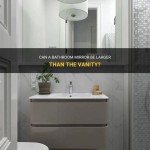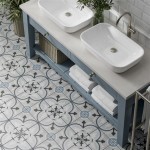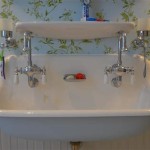Mounting Height Considerations for Bathroom Mirrors
Determining the appropriate mounting height for a bathroom mirror is crucial for both functionality and aesthetics. A poorly positioned mirror can lead to discomfort, visual distortion, and an overall diminished bathroom experience. This article explores the various factors that influence the ideal mirror height, providing guidance to achieve optimal placement.
Several elements contribute to the decision-making process, including the height of the individuals using the mirror, the type of mirror being installed, the overall design of the bathroom, and any pre-existing architectural features. Understanding these aspects allows for a tailored approach that addresses specific needs and preferences.
Understanding User Height and Accessibility
The primary consideration when determining mirror height is the height of the individuals who will be using it. The goal is to ensure that all users can comfortably see their reflection without straining or having to bend over excessively. This involves taking into account the average height of the users and any significant height differences.
A general guideline suggests positioning the center of the mirror at approximately eye level for the average user. For a standard mirror, this translates to a mounting height where the center of the mirror is roughly 60 to 65 inches from the floor. This is a starting point that can be adjusted based on the specific heights of the household members.
In households with significant height discrepancies, compromises may be necessary. One approach is to prioritize the height of the primary user. Another strategy involves selecting a larger mirror that provides a wider viewing area, accommodating both taller and shorter individuals. Tiltable mirrors can also offer a degree of adjustability, although they are less common in residential settings.
Accessibility considerations should also be addressed, especially in spaces designed for individuals with disabilities. The Americans with Disabilities Act (ADA) provides guidelines for mirror placement in accessible bathrooms. These guidelines stipulate that the bottom edge of the reflecting surface should be no higher than 40 inches above the finished floor. This ensures that individuals using wheelchairs can easily see their reflection.
Beyond ADA compliance, universal design principles advocate for creating spaces that are usable by people of all abilities to the greatest extent possible, without the need for adaptation or specialized design. This can involve incorporating features like adjustable-height mirrors or selecting larger mirrors that offer a wider range of visibility. Thoughtful planning ensures that the bathroom is functional and inclusive for all users.
Mirror Type and Its Impact on Mounting Height
The type of mirror selected significantly influences the optimal mounting height. Different mirror styles necessitate different considerations to maximize their aesthetic and functional potential. Framed mirrors, frameless mirrors, and medicine cabinets with mirrored doors each present unique challenges and opportunities.
Framed mirrors introduce the added dimension of the frame itself. When calculating the mounting height, it is crucial to consider the overall dimensions of the mirror, including the frame. The goal remains to position the reflecting surface at the appropriate height, taking into account the added visual weight of the frame.
Frameless mirrors offer a cleaner, more minimalist aesthetic. Their simplicity can make them easier to install and adjust, as there is no frame to complicate the process. However, the lack of a frame also means that the edges of the mirror are more vulnerable to chipping or damage. Therefore, careful handling and precise installation are essential.
Medicine cabinets with mirrored doors serve a dual purpose, providing both storage and a reflective surface. When installing a medicine cabinet, the mounting height should consider both the functionality of the storage compartment and the visibility of the mirror. It is often advisable to position the medicine cabinet so that the middle shelf is at approximately eye level for the average user. This ensures that the user can easily access the contents of the cabinet while also having a clear view of their reflection.
Full-length mirrors present a unique set of considerations. These mirrors are designed to provide a full-body reflection, and their mounting height should be adjusted accordingly. The bottom edge of a full-length mirror should typically be positioned close to the floor, while the top edge should extend well above the head of the tallest user. This ensures that the entire body is visible in the reflection.
Illuminated mirrors, which feature integrated lighting, are becoming increasingly popular. The mounting height of these mirrors should be determined in conjunction with the lighting design of the bathroom. The goal is to position the mirror so that the lighting provides adequate illumination without creating glare or shadows. The specific recommendations for mounting height will vary depending on the type and intensity of the lighting.
Bathroom Design and Architectural Considerations
The overall design of the bathroom and its architectural features play a significant role in determining the optimal mirror height. Factors such as the placement of the vanity, the height of the backsplash, the presence of windows or other architectural elements, and the overall style of the bathroom should all be taken into account.
The height of the vanity is a critical consideration. The mirror should be positioned in relation to the vanity to create a cohesive and balanced look. A general guideline is to leave a few inches of space between the top of the vanity and the bottom of the mirror. This prevents the mirror from feeling crowded or overwhelming the vanity.
If the bathroom features a backsplash, the mirror should be positioned above the backsplash to protect it from splashes and spills. The height of the backsplash will influence the overall mounting height of the mirror. It is important to ensure that the mirror is securely fastened to the wall above the backsplash.
The presence of windows or other architectural elements can also affect mirror placement. The mirror should be positioned to maximize natural light and to avoid creating any unwanted reflections or glare. If a window is located near the vanity, the mirror should be placed on the opposite wall or to the side to avoid reflecting the window light directly into the user's eyes.
The overall style of the bathroom should also be taken into consideration. In a traditional bathroom, a framed mirror with ornate details may be appropriate. In a modern bathroom, a frameless mirror with clean lines may be a better fit. The size and shape of the mirror should also complement the overall design of the bathroom.
In some cases, architectural constraints may limit the options for mirror placement. For example, a low ceiling or a protruding beam may restrict the height of the mirror. In these situations, it may be necessary to compromise on the ideal mounting height. However, it is always important to prioritize functionality and accessibility.
Ultimately, the optimal mounting height for a bathroom mirror is a matter of personal preference and individual needs. By considering the factors outlined in this article, it is possible to achieve a mirror placement that is both functional and aesthetically pleasing, enhancing the overall bathroom experience.
Before permanently affixing the mirror, it is advisable to temporarily hold it in place at different heights to assess the visual impact and ensure that it meets the needs of all users. This allows for adjustments to be made before committing to a final mounting position. Paying attention to detail during the mirror installation process ensures the best possible outcome for both function and appearance.

How High Should You Hang The Mirror In A Bathroom With Photos Design Morsels

Bathroom Mirror Size Calculator

Bathroom Measurement Guide These Are The Measurements You Need To Know Dimensions Floor Plans

What Is The Standard Height Of A Bathroom Vanity 2024 Guide

Standard Height For Bathroom Mirror Dimensions Vanity Sizes Vessel Sink

Standard Height Of Bathroom Fittings Engineering Discoveries

The Right Height For Your Bathroom Sinks Mirrors And More

Bathroom Mirror Size Calculator

The Right Height For Your Bathroom Sinks Mirrors And More

All Bathroom Dimensions You Need To Know
Related Posts







